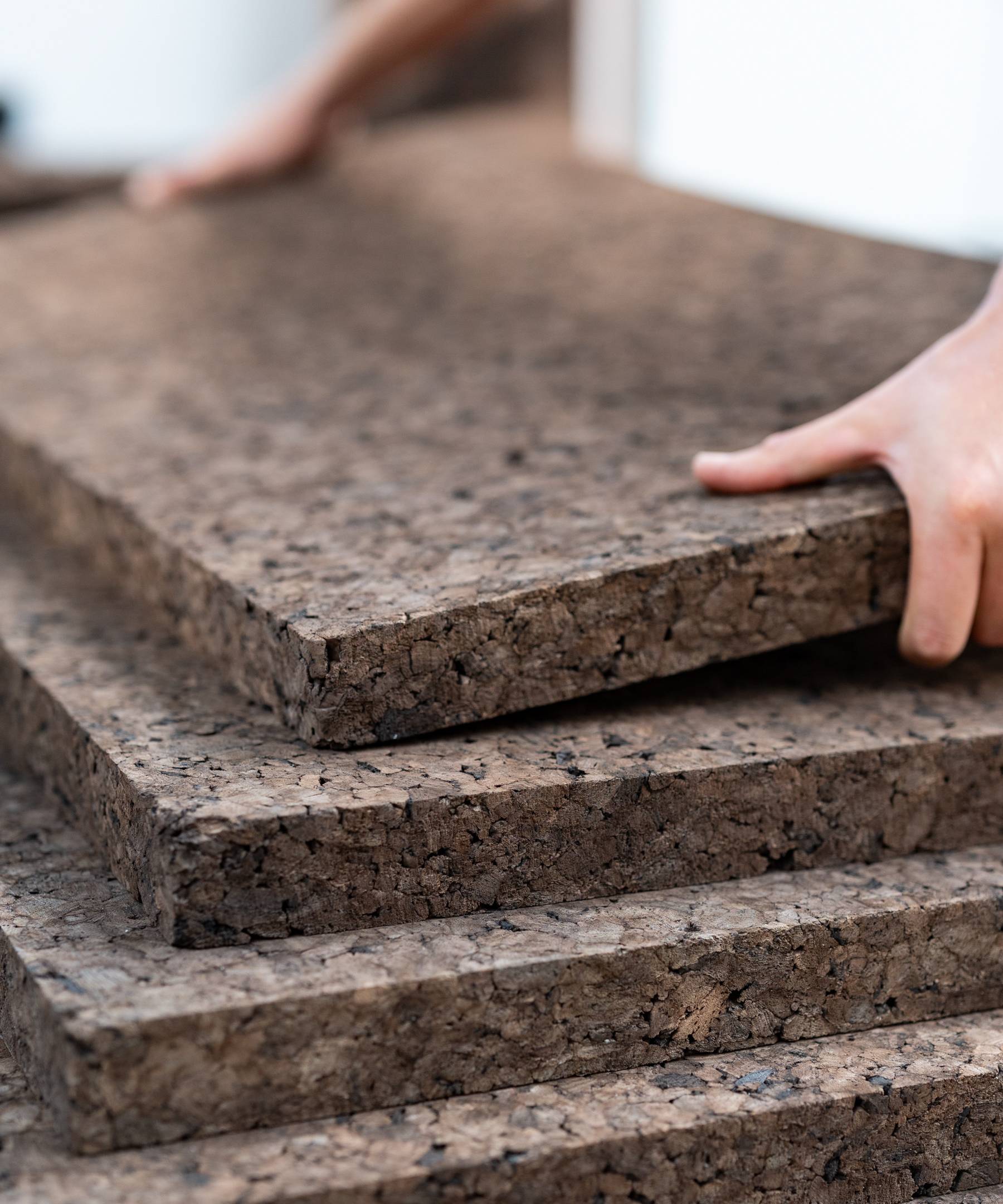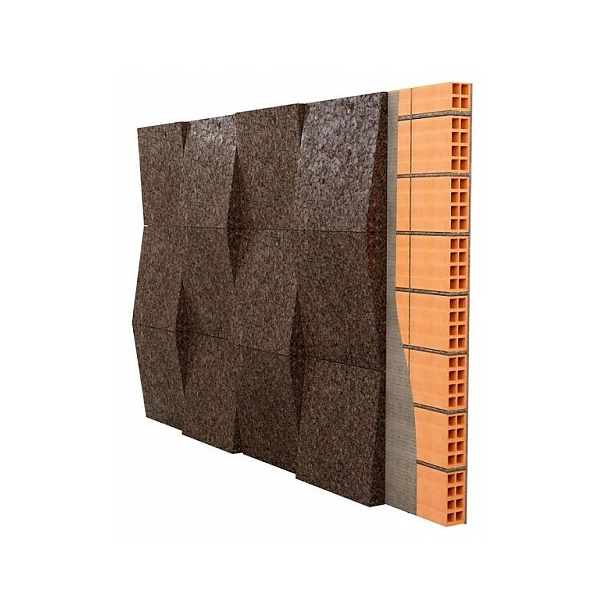Expanded cork insulation is one of the eco materials of the moment, with proponents ranging from RIBA to NASA.
You might be wondering if cork insulation could suit your self build project or energy-efficient home renovation. Is it truly eco-friendly, what makes it a good for home insulation, and which forms of cork insulation are available in the UK?
To answer these questions and learn about cork’s insulative thermal and acoustic properties, we interviewed the world’s leading cork producer, and an award-winning architectural firm which has made headlines with its cork-clad projects.
Edgar Nadais is Head of Sales at Amorim Cork Solutions, a construction-focused branch of the world’s largest cork producer, Amorim Cork, S.A., which is based in Portugal. Nadais has more than a decade’s experience in the cork trade.
What is cork insulation?
When we think of cork, many of us will picture a cork – the stopper in a wine bottle. This is essentially the same material used to make cork insulation.
Amorim Cork Solutions is a sub-brand of the world’s largest cork producer, and the bulk of its insulation products are made from waste cork left over from bottle stopper production.
“Stoppers are our main business, but we produce different types of products as Amorim Cork Solutions, and one of these is expanded cork insulation,” says Edgar Nadais, head of sales to the construction industry. “We take the branches of the tree, which are not used to produce the stoppers, and we make these into granules which are then treated with heat and pressure in an autoclave.”
This process extracts the cork’s resin, which acts as a natural binder to form the cork into a solid piece.
“We cut the blocks into several thicknesses to suit different purposes, mainly for use as insulation,” says Nadais. “From the raw material to the final block, the whole process takes about 20 minutes.”
This efficient use of waste cork is one reason why expanded cork insulation is considered an eco-friendly alternative to other materials such as mineral wool. Very little intervention is required to turn the branches of the cork oak (quercus suber) into an effective insulation product.

Cork science: why is it a good insulator?
Cork has a honeycomb-like structure of hexagonal cells. The cells trap pockets of air, which has low thermal conductivity and therefore limits heat transmission.
This accounts for cork’s thermal insulativeness – but according to Nadais, it’s the material’s density that makes the difference to its acoustic insulation.
“When you compare expanded cork with a traditional synthetic insulation, the cork is about five times denser,” he says.
More material typically means superior soundproofing, as a soundwave will require more energy in order to pass through the denser matter.


Nick Newman is the Founder of Studio Bark, a multi-award-winning, sustainability-focused architecture firm, based in London. Newman’s second venture, U-Build, aims to make construction accessible to more self-builders.
What are the benefits of cork insulation?
Cork insulation is not widely installed in the UK, but Nick Newman, Founder of Studio Bark, believes there’s potential for growth in its use.
“I think that as a result of cork insulation’s technical, environmental and [when used as cladding] aesthetic qualities, we will start to see it more and more,” says Newman, who has used cork extensively in acclaimed projects such as The Cork Studio.
Increased usage of expanded cork insulation could be good news for our buildings (and the environment), as the material has numerous benefits.
Most obviously, it’s an effective thermal insulator, with a lower thermal conductivity than that of rock wool insulation. The potential reduction in heat loss should mean lower energy usage, cheaper bills and cosier indoor temperatures.
Cork is also notable for its acoustic insulation performance. The material has been found to absorb up to 70% of sound, and therefore reduces noise transmission through walls and other surfaces.
If, like many buildings in the UK, your property is prone to damp and mould, then using cork insulation could play a part in managing these issues, as the material is naturally resistant to moisture transmission (one reason for its use as wine bottle stoppers) and breathable.
You might have some concerns over the fire safety of cork, given that it’s a type of wood. However, the material is relatively fire resistant when compared with other wood products. It burns slowly and does not produce a flame.
Cork is surprisingly durable. Much like memory foam, it has high viscoelasticity, which means it can flex and return to its original shape after it is compressed. (You’ll know this if you’ve ever tried to persuade a champagne cork back into the bottle.)
But the most important benefit of cork insulation, many would say, is the combination of its insulative properties with a relatively low environmental impact. While any effective insulation product provides eco benefits by limiting the need to use energy for heating, insulating with a natural material like cork does the same without causing the environmental harms associated with synthetic insulation production.
If you’re aiming to self-build a home that meets Passivhaus criteria, then cork would be one of the best qualifying choices for your insulation.
Another advantage to using this natural insulation material is that it’s non-toxic and hypoallergenic.
“Many people are unaware that some synthetic insulation materials are not allergy-friendly,” says Nadais. “Choosing expanded cork can be a good decision for your health, as well as your home.”

Types of cork insulation and their applications
Expanded cork insulation is produced in various forms to suit different uses and requirements. Popular types include:
- Boards or panels. These are used for insulating walls, rooves, and floors. Various thicknesses are available, and many examples can be used either within a wall or as an external cladding.
- Rolls. Thinner than boards, these products are most commonly used in smaller structures where space is limited, or as underlay for flooring.
- Granules: Used to fill gaps in ceilings, floors, and cavity walls.
- Spray: Cork is added as an insulative surface layer in the form of a spray.
Cork insulation options for your home:
Installation considerations
Using expanded cork insulation tends not to add much complexity to construction or renovation, but there are considerations to be made in some cases.
“The main methods for installing it are either as external wall insulation (EWI) or as a rainscreen cladding,” says Newman. “When using it as EWI – for example, over masonry – this might involve putting a parge coat over the brick for airtightness and levelling, and/or an adhesive. If using an adhesive, the type chosen will impact on the reusability and biodegradability of the insulation.
“For rainscreen cladding installations it can be fixed with batten and counter batten in a similar manner to traditional cladding,” he adds. “Stainless cladding crews can be fixed through the boards, and the heads can be hidden slightly below the surface of the cork, which springs back into place.”
Should you choose cork insulation for renovation or self-building?
There are transformative advantages to using expanded cork insulation, rather than a more commonplace synthetic option. As Newman puts it: “Cork is really an incredible, versatile material. It is naturally water resistant, needs no coat on top of it, has acoustic properties and can create a beautiful, matt finish.
“It is also 100% biodegradable if expanded cork is specified (as opposed to agglomerated cork, a type used in products such as corkboards).”
No building material is without its flaws – and in cork’s case, the main issue is the initial expense. Before VAT, a single 50mm-thick, 3-square-metre panel can cost upwards of £80. That’s more than ten times the price of certain mineral wool insulation products.
“It’s true that you’re spending more at the outset, but if you do the right calculations factoring in the lifetime of your house, you are saving money in the long run,” says Nadais. “In the end, you’re choosing a product that will perform better than others and has higher durability.”
Many examples of expanded cork insulation are fully recycled, fully recyclable, and therefore carbon-negative. Factoring in its eco credentials, there’s a compelling case to place cork insulation at the heart of your home.
Carefully chosen materials are fundamental to a home’s aesthetics, performance and environmental impact. For further eco-friendly inspiration, see our features on recycled plastic mortar, denim insulation and Irish moss lawns.
View the original article and our Inspiration here





Leave a Reply